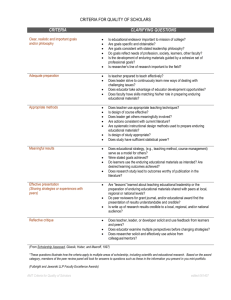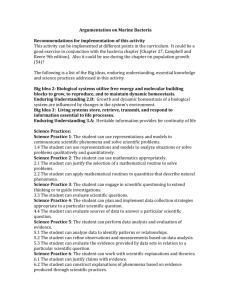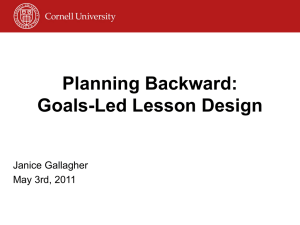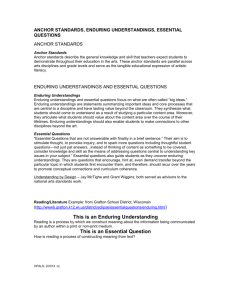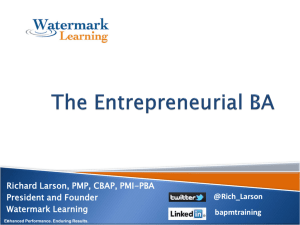My work
advertisement
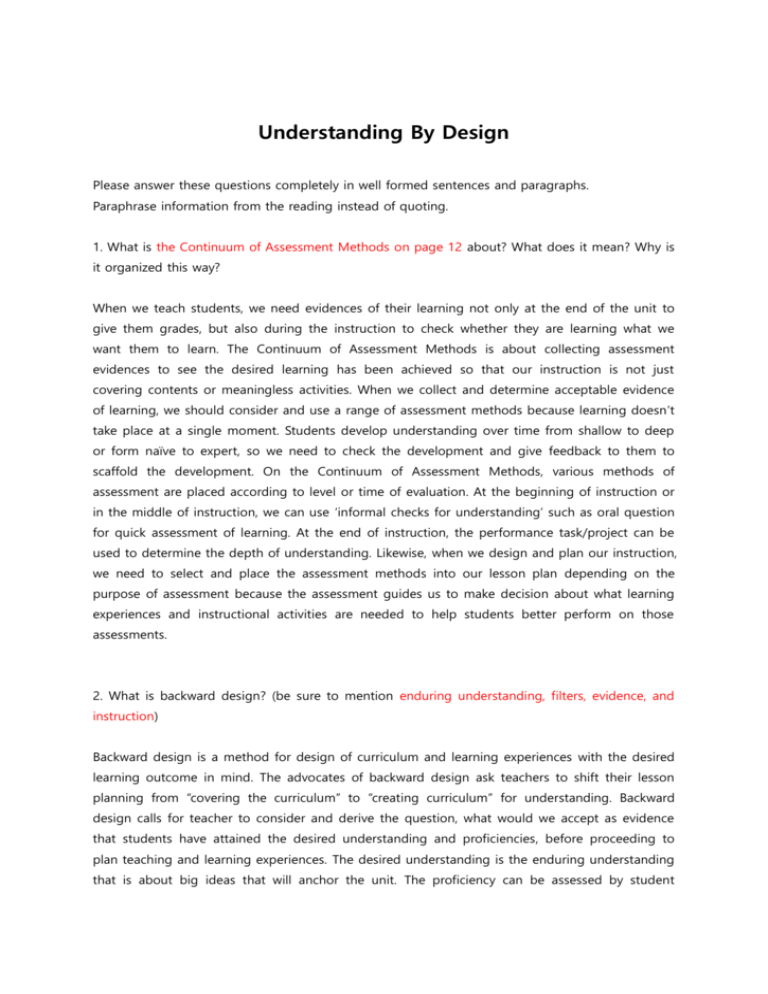
Understanding By Design Please answer these questions completely in well formed sentences and paragraphs. Paraphrase information from the reading instead of quoting. 1. What is the Continuum of Assessment Methods on page 12 about? What does it mean? Why is it organized this way? When we teach students, we need evidences of their learning not only at the end of the unit to give them grades, but also during the instruction to check whether they are learning what we want them to learn. The Continuum of Assessment Methods is about collecting assessment evidences to see the desired learning has been achieved so that our instruction is not just covering contents or meaningless activities. When we collect and determine acceptable evidence of learning, we should consider and use a range of assessment methods because learning doesn’t take place at a single moment. Students develop understanding over time from shallow to deep or form naïve to expert, so we need to check the development and give feedback to them to scaffold the development. On the Continuum of Assessment Methods, various methods of assessment are placed according to level or time of evaluation. At the beginning of instruction or in the middle of instruction, we can use ‘informal checks for understanding’ such as oral question for quick assessment of learning. At the end of instruction, the performance task/project can be used to determine the depth of understanding. Likewise, when we design and plan our instruction, we need to select and place the assessment methods into our lesson plan depending on the purpose of assessment because the assessment guides us to make decision about what learning experiences and instructional activities are needed to help students better perform on those assessments. 2. What is backward design? (be sure to mention enduring understanding, filters, evidence, and instruction) Backward design is a method for design of curriculum and learning experiences with the desired learning outcome in mind. The advocates of backward design ask teachers to shift their lesson planning from “covering the curriculum” to “creating curriculum” for understanding. Backward design calls for teacher to consider and derive the question, what would we accept as evidence that students have attained the desired understanding and proficiencies, before proceeding to plan teaching and learning experiences. The desired understanding is the enduring understanding that is about big ideas that will anchor the unit. The proficiency can be assessed by student performance that proves student’s enduring understanding as an evidence of learning. Backward design consists of three stages of process. The first stage of the backward design is to identify desired results. What is worthy and requiring of understanding? To find answers to the question, teachers consider our goals, examine established content standards, and review curriculum expectations. We need to establish curricular priorities among what we want to teach for a unit or subject. Top priority is on enduring understanding that we want students to get inside of and retain after they have forgotten many of the details. Four filters for selecting enduring understanding are: •Represent a big idea having enduring value beyond the classroom. •Reside at the heart of the discipline (involve “doing” the subject). •Require un-coverage (of abstract or often misunderstood ideas). •Offer potential for engaging students. The second step is to determine acceptable evidence. What is evidence of understanding? We need to consider the Continuum of Assessment Methods to decide what kind of assessments will be employed and when the evaluations will be needed. However, the determination of assessment methods and times is guidance for planning instructions to achieve acceptable evidence of learning, not the assessment itself. See the above question No. 1 for the detail. The Final phase of the backward design is to plan learning experiences and instruction. What learning experiences & teaching promote understanding, interest, and excellence? After identifying the desired results and assessments, we need to make choices about teaching methods, sequence of lessons, and resource materials. In sum, backward design, as opposed to the conventional lesson planning for covering topics in the textbook, helps teachers achieve their ultimate instructional goals which are about students’ enduring understanding of the unit or subject. From the assessor’s point of view, we need to make a plan of our instruction to assist our student to perform better on the assessment so that they can prove their understanding. 3. In your field and grade level come up with some enduring understandings, and critical (essential) questions. Explain why they are enduring and critical. What essential questions are raised by the topic or the subject? What, specifically, about the idea or topic do I want my students to come to understand? In Korean high school chemistry (for 11th and 12th graders), students need to understand what gives matter its own properties and what affect matter’s change – either physical or chemical. I want my students to think about the fundamental cause of distinct characters of each atom, which is electrostatic force and electronic configuration of its obitals. So I ask them to answer the question, why do atoms have different properties in spite of the fact that they are composed of the same particles – electrons, neutrons and protons? Why are there so many kinds of matter despite we have only about 100 elements and what makes each of them unique? => The answer is a diverse of structure because of their chemical bonding. What decides whether a reaction (either physical or chemical) will happen or which direction the reaction will take place? => According to Gibb’s free energy equation, a system seeks for lower energy state and the universe seek for greater entropy. The compromise of these competitions decides the direction of change. When a system’s equilibrium is disturbed, what happens there? => A system has tendency to recover its equilibrium state by changing. Le Chartlier’s principle helps students to predict the change. 4. What do Gardner, and Grant and McTighe consider contextual learning? Why is it important? Contextual learning is about understanding. Understanding involves the ability to use knowledge and skill in context, as opposed to doing something routine and on cue in out-of-context assignments or assessment items. In contextual learning, students can achieve a more complex and “enduring understanding” through analysis, synthesis, and evaluation of given accounts which are culminating in their own performance. Contextual learning helps students attain the knowledge that enables them to use their learning in new ways. In other words, contextual learning promotes transfer of what they have learned in school into application in the real world. 5. What does understanding mean? Understanding means to me internalizing knowledge and thus developing insight into a unit or the subject area because it gives a well organized structure to apparently discrete facts around the underlying principles. Understanding is important because it facilitates transfer of knowledge. When we understand a topic or subject, we can use knowledge and skill in sophisticated, flexible ways. As a result of “ongoing inquiry and rethinking”, we come to know when or under what conditions the knowledge is applicable. Understanding involves concepts, generalizations, theories, and mental links between facts. Six Facets of Understanding •Can explain •Can interpret •Can apply •Has perspective •Can empathize •Has self-knowledge

